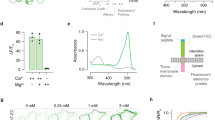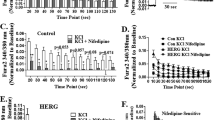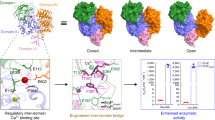Abstract
LETTVIN et al.1 predicted that lanthanum ions, because of their relatively small size and high charge density, should have a much greater electrostatic attraction for any negative calcium binding site than calcium ions themselves. This was borne out for the membranes of the barnacle muscle fibres2 and the lobster axon3. If negatively charged sites located in the membrane also serve to transport calcium ions across it, then lanthanum ions would be expected to displace calcium from these sites, and thereby inhibit the calcium ion flux. It has been shown that this is true for an artificial membrane with negative groups of phospholipids lining aqueous pores4. Data obtained by Weiss and Goodman5 and Van Breemen6 indicate that lanthanum ions also block the calcium transport across smooth muscle membranes. In smooth muscle physiology there is much uncertainty about the relative contribution of calcium influx to the initiation of contraction, and a calcium transport blocking agent would be very useful. In addition, information regarding the nature of the lanthanum blockade should contribute to the understanding of the cell membrane calcium transport system itself.
This is a preview of subscription content, access via your institution
Access options
Subscribe to this journal
Receive 51 print issues and online access
$199.00 per year
only $3.90 per issue
Buy this article
- Purchase on SpringerLink
- Instant access to full article PDF
Prices may be subject to local taxes which are calculated during checkout
Similar content being viewed by others
References
Lettvin, J. Y., Pickard, W. F., McColloch, W. S., and Pitts, C., Nature, 202, 1338 (1964).
Hagiwara, S., and Takahashi, K., J. Gen. Physiol., 50, 583 (1967).
Takata, M., Pickard, W. F., Lettvin, J. Y., and Moore, J. W., J. Gen. Physiol., 50, 461 (1966).
Van Breemen, D., and Van Breemen, C., Nature, 223, 898 (1969).
Weiss, C. B., and Goodman, F. R., J. Pharmacol. Exp. Therap., 169, 46 (1969).
Van Breemen, C., Arch. Int. Physiol. Biochem., 77, 710 (1969).
Baker, P. F., Blaustein, M. P., Hodgkin, A. L., and Steinhardt, R. A., J. Physiol., 200, 431 (1969).
Blaustein, M. P., and Hodgkin, A. L., J. Physiol., 200, 497 (1969).
Van Breemen, C., and Van Breemen, D., Biochim. Biophys. Acta, 163, 114 (1968).
Reuter, H., and Seitz, N., J. Physiol., 195, 451 (1968).
Shanes, A. M., and Bianchi, C. P., J. Gen. Physiol., 42, 1123 (1959).
Caldwell, P. C., Hodgkin, A. L., Keynes, R. D., and Shaw, T. I., J. Physiol., 152, 561 (1960).
Luxoro, M., and Yanez, E., J. Gen. Physiol., 51, 1155 (1968).
Author information
Authors and Affiliations
Rights and permissions
About this article
Cite this article
VAN BREEMEN, C., DE WEER, P. Lanthanum Inhibition of 45Ca Efflux from the Squid Giant Axon. Nature 226, 760–761 (1970). https://doi.org/10.1038/226760a0
Received:
Issue date:
DOI: https://doi.org/10.1038/226760a0
This article is cited by
-
Influence of colloidal bismuth subcitrate on enzyme secretion from isolated rat pancreatic acinar cells
Research in Experimental Medicine (1992)
-
Initiation of DNA synthesis in quiescent Swiss 3T3 and 3T6 cells by lanthanum
Bioscience Reports (1984)
-
Effects of calcium and lanthanum on phosphate efflux from nonmyelinated nerve fibers
The Journal of Membrane Biology (1982)
-
Calcium distribution and transport in myelinated nerve
Journal of Comparative Physiology ? A (1981)



